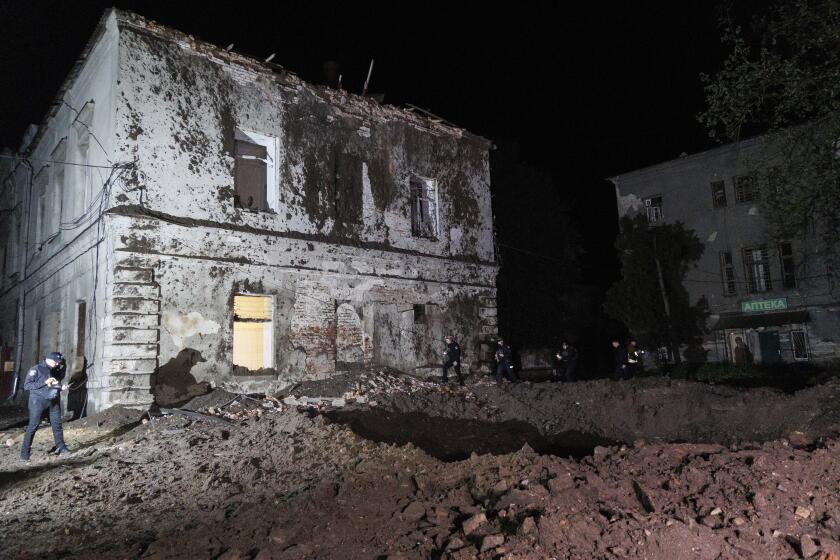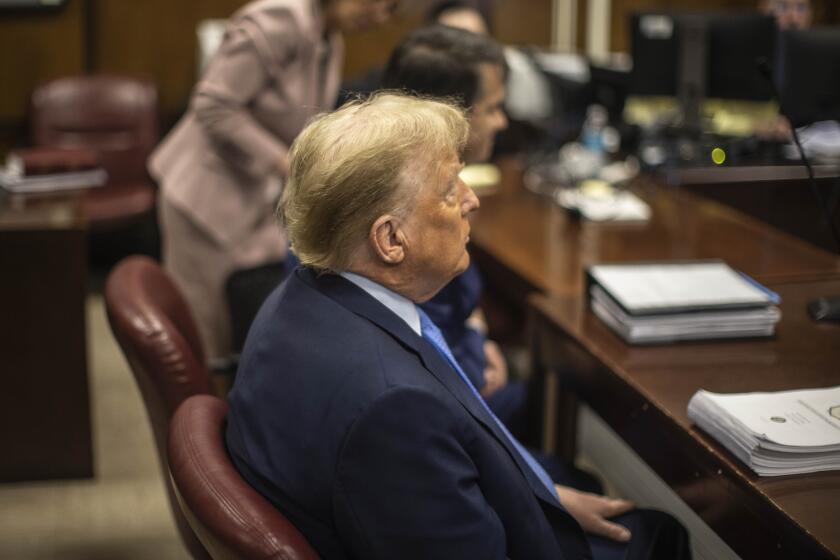Dress code
Pope Benedict XVI’s visit to the United States later this month has inspired speculation about what the pontiff will say to his sometimes restive American flock. Will he use a lecture at Catholic University in Washington to chastise Catholic colleges and universities for succumbing to secularism? Will he make more than an oblique reference to the pedophilia scandal that led to the resignation of Cardinal Bernard Law as the archbishop of Boston (a city not on the pope’s itinerary)?
And there’s another interesting question for American Catholics on both the left and the right: What will the pope wear?
When Benedict celebrates Mass in Yankee Stadium on April 20, he will be clothed in the raiment of his office -- a poncho-like vestment called a chasuble and the double-peaked bishop’s cap known as a miter. Asking if the pope will be dressed up is like asking whether the pope’s Catholic.
But the Catholic Church is a house with many rooms, and those rooms have different clothes hanging in the closets. To the delight of conservative Catholic bloggers, Benedict -- the pope who has ordered wider use of the Latin Mass of the Council of Trent -- has lately been donning elaborately embroidered vestments and miters in what is called the “Roman” style, in contrast with the neo-medieval “Gothic” style that made a comeback after the Second Vatican Council.
The Gothic style features short, squat miters and full, flowing chasubles. The Roman style, a product of the Baroque era, produced the super-tall miters beloved of anti-Catholic polemicists (the cartoonist Thomas Nast portrayed bishops as crocodiles, with the two points of their miters forming jaws) and chasubles reduced to the point that they resemble an embroidered sandwich board. This style of chasuble is known as the “fiddleback” because the front portion is shaped like a violin.
Fiddleback chasubles and skyscraper miters were the norm in the Roman Catholic Church through the early part of the 20th century. The Gothic style, which hearkened back to the 12th century, was viewed with suspicion in Rome partly because it was favored by priests of the Church of England who wanted to reestablish their church’s Catholic heritage. (Ironically, some of those “Anglo-Catholic” clergymen were imprisoned in the 19th century for wearing what Protestant-minded Anglicans regarded as the “rags of popery.”)
But the Gothic revival was also supported by some Roman Catholic scholars, the same scholars whose studies laid the groundwork for the liturgical reforms -- including Mass with the priest facing the congregation -- that followed the Second Vatican Council. In a 1931 book celebrating Gothic vestments, the influential Benedictine monk E.A. Roulin fulminated against the “horribly heavy” and “vulgar” fiddleback chasuble.
When I served Mass as an alter boy at in Pittsburgh in the early 1960s, the vestments were all Gothic, the fiddlebacks of the 1940s and 1950s having long been mothballed. I didn’t realize, until I read Garry Wills’ “Bare Ruined Choirs,” that Gothic vestments were associated with liberal Catholicism.
After Vatican II, the pope caught up with Pittsburgh. When Pope Paul VI celebrated Mass in Yankee Stadium in 1965, he wore a flowing but not particularly elaborate Gothic chasuble and a mid-sized miter. His successors -- John Paul I and John Paul II -- also favored Gothic chasubles, though they occasionally donned skyscraper miters.
Then the papacy passed to Cardinal Joseph Ratzinger, a critic of post-Vatican II liturgical practices who traced his own vocation to the priesthood to a youthful infatuation with the old Mass as it was celebrated in Baroque-loving Bavaria. In a 1997 memoir, Ratzinger recalled how “it was a riveting adventure to move by degrees into the mysterious world of the liturgy which was being enacted before us and for us at the altar.”
Assisted by Archbishop Piero Marini, the papal master of ceremonies he inherited from John Paul II, Benedict sported Gothic vestments and modest miters for a while. But last year, the pope replaced Marini with a prelate with the same last name, Msgr. Guido Marini. With the assistance of Marini No. 2, Benedict has returned to his liturgical roots, sporting massive miters, celebrating Mass in the Sistine Chapel with his back to the congregation and leading Good Friday services vested in a fiddleback chasuble. The pope’s aides say that his choice of vestments is designed to demonstrate continuity with the church’s past. Liberals are more inclined to see it as a slap at the spirit of Vatican II.
Even some Catholics might wonder why so much attention is paid to the pope’s preferences in vestments. If hemlines can rise and fall, why not miters? Besides, special robes for priests and bishops are a tradition, not a matter of faith, and whether Gothic or Roman, ecclesiastical vestments originated in the everyday civilian dress of the Roman Empire. “The first Christians were waiting for the second coming of Christ, which they expected in their own lifetime and so made no attempt to formalize their religion,” writes Janet Mayo in “A History of Ecclesiastical Dress.” “They certainly had no desire to adapt or create specifically Christian clothing.”
But that was to change. The introduction of vestments coincided with a greater distinction between clergy and laypeople and the belief that only ordained priests and bishops could “validly” celebrate Mass and bring about the transformation of bread and wine into the body and blood of Christ. To a greater or lesser extent, the churches of the Reformation rejected this view. They emphasized the “priesthood of all believers” and defined the Mass (or Eucharist) as a memorial meal rather than as a sacrifice offered by the priest for the forgiveness of sins. Not so coincidentally, many Protestant churches also did away with or simplified clerical vestments even as the robes worn by Catholic prelates were becoming more elaborate and over the top.
But in the late 20th century, there was a remarkable convergence in the way the Eucharist was celebrated and in the way it was interpreted. Vestments, lighted candles, even incense became common in Episcopal, Lutheran and even Methodist churches, even as Catholic Masses began to be celebrated in the vernacular to the accompaniment of treacly folk hymns.
Meanwhile, Catholic theologians reached surprising common ground with scholars from other churches on issues that long had divided the two forms of Christianity. Most notable was a 1971 document in which theologians and bishops from the Roman Catholic and Anglican churches reached what they called “substantial agreement” on the meaning of the Eucharist -- an agreement that was too much of a compromise for Ratzinger and other Catholic conservatives.
The typical American Catholic wouldn’t be aware of this theological fence-mending, but he would notice, on visiting a Lutheran or Episcopal Church, that the service didn’t seem very different from what went on at his parish: It would be in English, the minister would be wearing a (Gothic) chasuble, and at some point the congregants would offer one another the handshake of peace.
That is precisely the problem for Catholics known as “rad trads” -- radical traditionalists. They prefer their Mass in Latin, their priest in a fiddleback and their pope sporting a miter tall enough to touch the heavens. It’s not about fashion, they would say, it’s about faith. We’ll see if they get their wish when Benedict suits up at Yankee Stadium.
More to Read
Start your day right
Sign up for Essential California for news, features and recommendations from the L.A. Times and beyond in your inbox six days a week.
You may occasionally receive promotional content from the Los Angeles Times.







